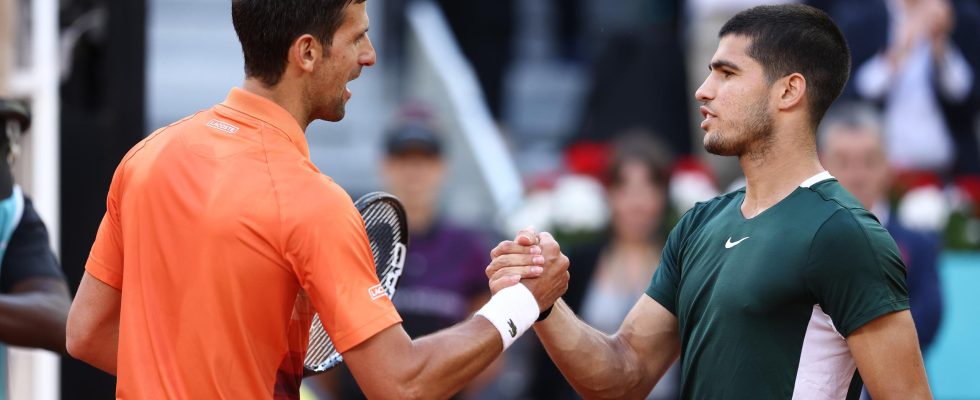The start of the match: Alcaraz advantage
Carlos Alcaraz is used to starting off with a bang. In Madrid, he had sent a clear message from the first point: in the wake of a curved cross return, he had left Novak Djokovic on the spot with a winning forehand missile along the line. An entry break had followed for the Spaniard who had started the showdown, before however losing the first set in the decisive game.
Roland Garros
The best ratio in history: what is Djoko’s secret on tie-breaks?
3 HOURS AGO
The fact remains that Alcaraz has cultivated since these thundering starts, particularly in this fortnight (with the exception of an entry break conceded against Lorenzo Musetti). For Djokovic on the other hand, the start-ups are often more laborious as his starts against Davidovich Fokina and Khachanov have shown. This will be the first challenge of this half.
Alcaraz strikes hard from the start with a magnificent passing to break Djokovic
First-ball quality: Djokovic advantage
It is a fundamental asset of his game, often underestimated. The world’s best receiver, Djokovic gets plenty of free runs (or easy second shots) by hitting the lines on his first ball. If he had been surprised from the start in Madrid, he had then won 21 (!) points in a row on his commitments thanks to a high percentage and very precise zones (90% of points won behind the first in the 1st set ).
Alcaraz is effective in this area, but a little less surgical and the Serb has such an eye for the return that the exchange should be initiated more systematically on the Spaniard’s service. On the second ball, however, Djokovic does not have a clear advantage even if he has increased his speed in recent years. Alcaraz’s outside kick had even bothered him a lot in Madrid, forcing him to step back as rarely to control it. But the Madrid altitude accentuated its effect, which will not be the case on the Philippe-Chatrier court.
Explosiveness and aggressiveness: Alcaraz advantage
Alcaraz like Djokovic, the man-elastic, move remarkably well. They both have the ability to make their opponent play the shot more and master the art of sliding perfectly. But on clay, the Murcian adds something animal, natural which also characterizes a certain Rafael Nadal. Mounted on springs, it has the answer to everything: curved or grazing trajectories, nothing poses any apparent difficulty.
In Madrid, this physical presence had marked Djokovic, forced to leave him too often the initiative of the game: Alcaraz forced him to anticipate, on the heels. Always on time on the ball, he constantly had multiple options including serve and volley and drop shot (used more than ten times with great success). His last fabulous forehand shift to close the debates was in the image of this leitmotif: attacking the first at all costs thanks to a liveliness of small out-of-standard supports.
A crazy set point: how Alcaraz came back in the match against Djokovic
The diagonals: equality
- Forehand: Alcaraz advantage
Technically more natural in the Spaniard, the forehand is a lethal weapon which “Carlitos” had made remarkable use of in the Caja Magica. Both capable of taking the ball early and relatively flat, especially in his shifts like a certain Roger Federer, as well as giving him a lot of topspin to gain ground, Alcaraz had attacked and pushed Djokovic back in this diagonal . A real demolition company despite some waste.
- Backhand: Djokovic advantage
Backhand, Alcaraz does not defend badly either. When he distributes in the court, he can print a lot of speed on the ball and alternates well on occasion with a very controlled grazing slice. But he sometimes rushes by wanting to do too well. It was by giving in on this side twice consecutively that he had allowed Djokovic to catch up with Madrid (4-4) in the first set. In this diagonal, the Serb has no rival on the circuit in terms of regularity. Capable of neutralizing, as well as suddenly overflowing along the line, he is also formidable in passing.
Endurance: equality
They are 16 years apart, but during this unique Madrid duel which lasted 3:35, neither of them really failed physically. Despite his 35 springs, Djokovic had responded to the infernal intensity printed by Alcaraz who himself came out of a great battle against… Rafael Nadal. No one before the Murcian had managed to win against both monsters back-to-back in a clay-court tournament, which already said a lot about his energy reserves. During this fortnight at Roland-Garros, “Carlitos” has drawn less so far, but “Nole” has shown against Khachanov that he has mastered the long format more than ever.
When it comes to mental stamina, both men had rivaled each other in resilience at Madrid. While he was trailing by a set, Alcaraz had shown a lot of character to dismiss two break points at 4-4 then 5-5 (on a drop shot) in the 2nd set before resetting the counters to zero. And what about Djokovic in the 3rd? Six break points saved including a match point at 5-4 from an ace, when he had just lost a monstrous exchange of 22 shots… It was finally on his 51st winning shot (against 24), the 35th in forehand (against 6), that the Murcian had gone to seek his triumph. Will audacity still end up paying off in the best of five sets? Answer Friday.
Roland Garros
Ferrero, the other brain of Alcaraz
5 HOURS AGO
Roland Garros
Alcaraz-Djokovic: what time and on what channel to watch the shock semi-final?
YESTERDAY AT 7:03 PM

